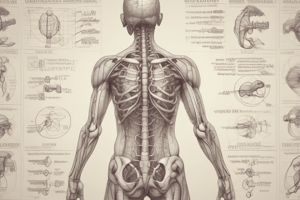Podcast
Questions and Answers
Which valve of the heart has three cusps attached to cone-shaped papillary muscles by tendons?
Which valve of the heart has three cusps attached to cone-shaped papillary muscles by tendons?
- Aortic valve
- Pulmonary valve
- Mitral valve
- Tricuspid valve (correct)
Where do the atria of the heart receive blood from?
Where do the atria of the heart receive blood from?
- Pulmonary veins and coronary arteries
- Pulmonary arteries and aortic arch
- Pulmonary trunk and aorta
- Inferior and superior vena cava (correct)
What is the structure that originates action potentials in the heart and acts as a pacemaker?
What is the structure that originates action potentials in the heart and acts as a pacemaker?
- Atrioventricular bundle
- Interventricular septum
- Atrioventricular node
- Sinoatrial node (correct)
Which part of the heart conducts action potentials to the apex of each ventricle?
Which part of the heart conducts action potentials to the apex of each ventricle?
Which artery branches off the aortic arch?
Which artery branches off the aortic arch?
Where does the ascending aorta branch into right and left coronary arteries?
Where does the ascending aorta branch into right and left coronary arteries?
Which artery is found in the abdominal aorta region?
Which artery is found in the abdominal aorta region?
Where is the thoracic aorta located?
Where is the thoracic aorta located?
Which artery is not mentioned as branching off the aortic arch?
Which artery is not mentioned as branching off the aortic arch?
What is the primary function of the cardiovascular system?
What is the primary function of the cardiovascular system?
Which component of blood plays a crucial role in separating pulmonary and systemic circulations?
Which component of blood plays a crucial role in separating pulmonary and systemic circulations?
What is the main function of plasma in the blood?
What is the main function of plasma in the blood?
Which element ensures one-way blood flow in the cardiovascular system?
Which element ensures one-way blood flow in the cardiovascular system?
What triggers changes in the heart's contraction rate and force to match changing metabolic needs?
What triggers changes in the heart's contraction rate and force to match changing metabolic needs?
Which part of the blood vessels is responsible for carrying oxygenated blood away from the heart?
Which part of the blood vessels is responsible for carrying oxygenated blood away from the heart?
Which structure allows action potentials to pass through into the interventricular septum?
Which structure allows action potentials to pass through into the interventricular septum?
Where are action potentials carried from the bundle branches to the ventricular walls and papillary muscles?
Where are action potentials carried from the bundle branches to the ventricular walls and papillary muscles?
What is the main function of the Circulatory System mentioned in the text?
What is the main function of the Circulatory System mentioned in the text?
What is the main function of veins compared to arteries?
What is the main function of veins compared to arteries?
Which vessels exit the lungs and enter the left atrium?
Which vessels exit the lungs and enter the left atrium?
Where does the aorta exit from?
Where does the aorta exit from?
What is the main function of the lymphatic system?
What is the main function of the lymphatic system?
Which of the following is NOT a function of the lymphatic system?
Which of the following is NOT a function of the lymphatic system?
Where does excess interstitial fluid enter to become lymph?
Where does excess interstitial fluid enter to become lymph?
Which vessel returns blood from the body to the right atrium?
Which vessel returns blood from the body to the right atrium?
What is absorbed from the digestive tract via lacteals in the lymphatic system?
What is absorbed from the digestive tract via lacteals in the lymphatic system?
Which of the following is NOT a type of vein in the systemic circulation?
Which of the following is NOT a type of vein in the systemic circulation?
Flashcards are hidden until you start studying




